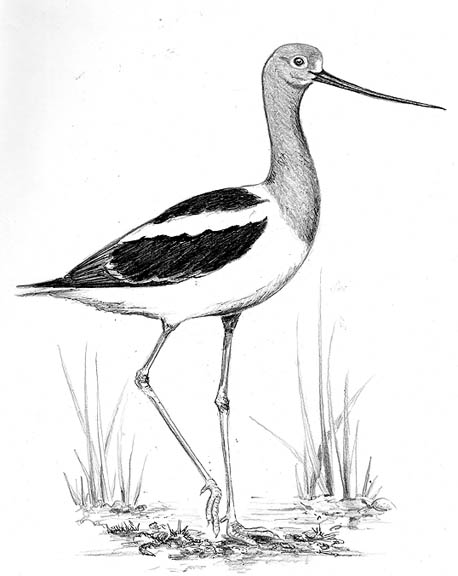
Dear Bird Folks,
I’ve read that an American Avocet is being seen on Yarmouth’s Seagull Beach. Have you seen this particular bird yourself? Is it worth a trip to see it?
– Paul, Freetown, MA
No and yes, Paul,
Even during these scary times, lots of people are still traveling. (I’ve never seen so many colorful license plates this late in the season.) Yet, personally, I haven’t been across the Bass River Bridge since last March. While I have nothing against Yarmouth, it happens to sit on the other side of the BRB, so there will be no avocet sighting for me this time. Is seeing an avocet worth the trip? OMG, yes! Birders travel all kinds of crazy miles just to spot an odd sparrow or some other bird that looks only marginally different than many other birds they’ve already seen. This is not the case with the American Avocet. It looks like no other bird in your entire bird book. Yes, you should go see it. Just get there early, or you’ll have to deal with the cars with all of those colorful license plates.
Standing eighteen inches high, the American Avocet is one of our most elegant shorebirds. Its legs are long and thin, and the body is white, with black wings and a white stripe. During the breeding season their heads and necks turn rusty/red, like the belly of an Eastern Bluebird. But the most noticeable feature, on a bird that is nothing but noticeable features, is the beak. Close to four inches long (seems longer), the beak has an upward curve and is super-thin (even thinner than the legs), as if it was drawn with a pencil. They say this gives the bird a graceful appearance, which is true, but it makes me wonder how can it possibly eat with such a skinny thing. It doesn’t look useful for anything, except maybe to reach under the refrigerator for a lost pill.
The typical avocet feeding method is known as “scything” or sweeping the bill back and forth thorough the water. This is similar to how Roseate Spoonbills feed, but spoonbills have a “spoon” on the end of their beaks, not a skinny pill plucker. Yet, avocets are very successful foragers. They are able to snag a whole host of items from – tiny fish to insects to worms. They also consume a fair number of small seeds (probably for roughage).
The reason why the news of this Yarmouth bird is so exciting is that avocets aren’t normally found in New England. They tend to breed thousands of miles from here in California, Montana, Utah and even Roswell, New Mexico, where they are often seen associating with aliens. Their nests are nothing special, usually just a scrape in the sand and sparsely lined with vegetation. The nests are frequently close to water, which can be a problem if the water level rises. But the resourceful birds have been known to add more material to the nest in order to keep their eggs dry. It’s sort of like what I do in my basement so my stuff won’t get wet. I’m not saying my basement floods, but yeah, it does.
An avocet nest may not be anything special to look at but during territorial displays the birds do something that actually is special. If a neighboring pair tries to encroach on another couple’s territory, the four birds may perform a “circling display.” This sounds like a ritual at a small family wedding and it actually looks like it, too. This is how it goes down: The four birds face each other at close range, with their heads lowered and their super-skinny beaks pointing to the center of the circle. While still staring at each other, the entire group will begin to rotate, like it’s a Maypole dance. Eventually, one of the birds may get tired (or dizzy) of the whole thing and will start a brief skirmish, and that’s the end of it. It’s a bit anticlimactic, but cool to see.
Like other shorebirds, baby avocets are precocial, meaning they are up and active a few hours after hatching. They receive no food from their parents, but do huddle beneath them for warmth and protection from harsh weather. After the breeding season they all head to the wintering grounds, which are often along coastal areas. Both California and Texas attract large numbers of migrating avocets, but others fly east to Florida and the Carolinas. And, occasionally, one will wander up to New England, where it will cause all sorts of excitement with the local birders. (It doesn’t take much to get birders excited.) Each winter, avocets lose their rusty coloring and are now black and white, looking like skunks…with skinny beaks. But in any plumage, they don’t look like any other bird in your bird book. Look in there, you’ll see.
The last avocet I saw on Cape Cod was back in the ‘80s. The bird was hanging out on the breakwater near the Provincetown Inn. In order to see it, I had to take a long awkward walk on the slippery breakwater, but in those days I could actually do something like that. Here’s a fun fact that is totally unrelated to birds: The swimming pool at the Provincetown Inn is in the shape of a Pilgrim’s hat. Just thought you should know that.
Yes, Paul, you definitely should try to see the American Avocet in Yarmouth. The way things are going right now, it could be a while before any of us can easily travel to Texas, Utah or Roswell. Just remember to take your binoculars. They will help you ] get a better view of the bird…and maybe of me, standing on the other side of the Bass River. I’ll wave to you.